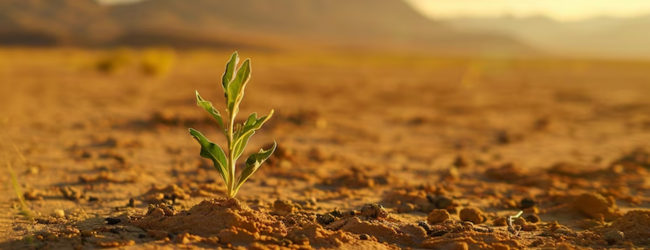Table of contents
- What is Dryland Farming?
- Comparing Dryland Farming, Dry Farming, and Rainfed Farming
- Dryland Cultivation as a Pillar of Sustainability
- Essential Crops and Sectors
- Strategies and Techniques to Aid Dryland Cultivation
- Government Initiatives for Dryland Farming
- Key Takeaways
- Need Expert Guidance?
- Conclusion
- Frequently Asked Questions (FAQs)
In a world increasingly grappling with water scarcity and the impacts of climate change, dryland farming emerges as a critical agricultural practice. It represents a unique approach to food production, tailored to the challenging conditions of regions with limited and often unpredictable rainfall. This blog delves into the intricacies of dryland farming, exploring its definition, distinguishing it from related concepts, highlighting its role in sustainability, identifying key crops and sectors, outlining essential cultivation strategies, and examining the support provided by government initiatives. Understanding dryland farming is crucial for ensuring food security and fostering resilient livelihoods in water-stressed environments.
What is Dryland Farming?

Dryland farming is a set of agricultural techniques specifically adapted for areas with low annual rainfall, typically defined as receiving less than 500-750 mm (20-30 inches) of precipitation per year. The primary focus in dryland farming is on conserving soil moisture and maximizing its efficient use for crop production. Unlike farming in more humid regions that rely on consistent rainfall or irrigation, dryland agriculture necessitates careful planning, specific cultivation methods, and the selection of drought-tolerant crops. The success of dryland farming hinges on the ability to capture and retain what little moisture is available in the soil profile.
Comparing Dryland Farming, Dry Farming, and Rainfed Farming
While the terms are often used interchangeably, there are subtle distinctions:
- Dryland Farming: This specifically refers to farming in regions with low annual rainfall (as defined above) and emphasizes techniques for conserving and utilizing limited soil moisture. It acknowledges the inherent water scarcity and actively seeks to mitigate its impact through specific practices.
- Dry Farming: This term is sometimes used synonymously with dryland farming, but it can also refer more broadly to any farming system that does not rely on artificial irrigation. This could include regions with moderate rainfall where water conservation is still important.
- Rainfed Farming: This is a broader category encompassing all agricultural practices that depend solely on rainfall for water. This includes both dryland regions with minimal rainfall and areas with moderate to high rainfall where irrigation is not necessary. Therefore, all dryland farming is rainfed, but not all rainfed farming is dryland farming.
In essence, dryland farming is a specific type of rainfed agriculture characterized by significant water limitations and the implementation of specialized moisture-conserving techniques.
Dryland Cultivation as a Pillar of Sustainability
Dryland farming plays a vital role in achieving agricultural sustainability, particularly in vulnerable regions:
- Food Security in Arid and Semi-Arid Regions: It enables food production in areas where conventional farming with irrigation is not feasible or sustainable due to water scarcity. This directly contributes to local and regional food security.
- Soil Health and Conservation: Many dryland farming techniques, such as reduced tillage, mulching, and cover cropping, are inherently beneficial for soil health, preventing erosion by wind and water, and improving soil structure and fertility.
- Water Conservation: The core principle of dryland farming is efficient water management, reducing reliance on scarce water resources and promoting their sustainable use.
- Biodiversity: The cultivation of drought-tolerant indigenous crops often supports agrobiodiversity, contributing to more resilient and adaptable agricultural systems.
- Climate Resilience: By adapting to low rainfall conditions and promoting soil health, dryland farming systems can be more resilient to the impacts of climate change, such as prolonged droughts and erratic rainfall patterns.
- Livelihood Security: For communities in dryland regions, successful dryland farming provides a crucial source of income and livelihood, contributing to economic stability and reducing dependence on external aid.
Essential Crops and Sectors

Dryland farming supports a range of crops and livestock sectors specifically adapted to arid and semi-arid conditions:
- Grains: Drought-tolerant cereals like millets (pearl millet, finger millet, foxtail millet, sorghum), barley, and certain varieties of wheat are staples in many dryland regions due to their ability to thrive with limited water.
- Pulses: Legumes such as chickpeas, pigeon peas, lentils, and various types of beans are crucial for protein and also contribute to soil health through nitrogen fixation.
- Oilseeds: Crops like groundnut, mustard, sesame, and sunflower can be successfully cultivated in dryland areas, providing essential oils.
- Fodder Crops: Cultivating grasses and legumes specifically for livestock feed is an integral part of dryland farming systems, supporting animal husbandry.
- Livestock: Cattle, sheep, and goats are often well-suited to dryland environments, utilizing sparse vegetation and contributing manure for soil fertility. Nomadic and semi-nomadic pastoralism are traditional livestock rearing practices in many dryland regions.
- Fruits: Certain drought-hardy fruit trees like dates, pomegranates, and some varieties of citrus can be grown with appropriate water management techniques.
💡 Pro Tip: If you want to start a Business but have too many doubts, connect with a Business expert from Boss Wallah for guidance – https://bw1.in/1116
Strategies and Techniques to Aid Dryland Cultivation
Successful dryland farming relies on a combination of strategies and techniques focused on water conservation and efficient resource management:
- Water Harvesting: Implementing methods to capture and store rainwater, such as constructing farm ponds, check dams, and contour bunds.
- Soil Moisture Conservation: Practices like mulching (using organic materials to cover the soil), minimum tillage (reducing soil disturbance), and contour plowing (plowing across the slope) help retain soil moisture and reduce evaporation.
- Selection of Drought-Tolerant Crops: Choosing crop varieties that are specifically adapted to low rainfall conditions, have shorter growing seasons, and are efficient in water use.
- Crop Rotation and Intercropping: Rotating different crops and planting compatible crops together can improve soil health, reduce pest and disease pressure, and optimize water and nutrient utilization.
- Efficient Planting Techniques: Using appropriate planting density and timing to maximize water availability for each plant.
- Weed Management: Controlling weeds effectively as they compete for limited soil moisture and nutrients.
- Soil Fertility Management: Utilizing organic fertilizers, green manure, and cover crops to improve soil structure and water-holding capacity.
- Water-Efficient Irrigation (where feasible): In some cases, supplemental irrigation using efficient methods like drip irrigation can be employed strategically to support critical growth stages.
- Weather Forecasting and Advisory Services: Utilizing weather information to make informed decisions about planting, harvesting, and water management.
ALSO READ | How to Start Pig Farming in India: A Complete Guide (2025)
Government Initiatives for Dryland Farming

Recognizing the importance of dryland farming, governments in many countries, including India, have implemented various initiatives to support and promote its adoption:
- Research and Development: Investing in research to develop drought-tolerant crop varieties, improve dryland farming techniques, and understand the specific challenges of different dryland agro-ecological zones.
- Extension Services: Providing farmers with training, information, and technical assistance on best practices in dryland farming.
- Financial Assistance and Subsidies: Offering financial support for adopting water conservation technologies, purchasing drought-resistant seeds, and implementing sustainable land management practices.
- Watershed Development Programs: Implementing integrated watershed management approaches that focus on water harvesting, soil conservation, and improving overall land productivity in dryland regions.
- Insurance Schemes: Providing crop and livestock insurance to mitigate the risks associated with unpredictable weather conditions in dryland areas.
- Market Linkages: Facilitating access to markets for dryland agricultural produce to ensure fair returns for farmers.
- Awareness Campaigns: Educating farmers and the wider public about the importance of dryland farming and sustainable land management practices.
Key Takeaways
- Dryland farming is a specialized agricultural system adapted to regions with low annual rainfall, focusing on water conservation.
- It differs from dry farming and rainfed farming by its specific emphasis on managing significant water scarcity.
- Dryland cultivation is crucial for food security, soil health, water conservation, biodiversity, climate resilience, and livelihood security in arid and semi-arid regions.
- Key crops include drought-tolerant grains, pulses, and oilseeds, along with livestock adapted to these environments.
- Successful dryland farming relies on a range of strategies and techniques focused on capturing and conserving soil moisture.
- Government initiatives play a vital role in supporting research, extension, financial assistance, and infrastructure development for dryland farming.
Need Expert Guidance?
Starting a business can be challenging, but you don’t have to do it alone! At Boss Wallah, our 2,000+ business experts are ready to provide valuable insights and guidance. Whether you need help with marketing, finance, sourcing, or any other area of any business, our business experts are here to help you succeed- https://bw1.in/1116
Confused about Which Business to Start?
Want to start your own business but unsure which one to choose? Explore Boss Wallah, where you’ll find 500+ courses by successful business owners, featuring practical, step-by-step guides on starting and growing various businesses. Find your perfect business idea today – https://bw1.in/1111
Conclusion
Dryland farming is more than just a way of growing food in challenging environments; it is a testament to human ingenuity and adaptation. As water scarcity becomes an increasingly pressing global issue, the principles and practices of dryland farming offer valuable lessons for sustainable agriculture in all regions. By embracing water-wise techniques, cultivating resilient crops, and supporting the livelihoods of dryland communities, we can unlock the potential of these often-marginalized lands and contribute to a more food-secure and environmentally sustainable future.
Frequently Asked Questions (FAQs)
- What is the minimum rainfall required for dryland farming?
- Generally, areas receiving less than 500-750 mm (20-30 inches) of annual rainfall are considered suitable for dryland farming. However, the specific threshold can vary depending on temperature, evaporation rates, and soil type.
- Are fertilizers used in dryland farming?
- While synthetic fertilizers may be used sparingly, the focus in sustainable dryland farming is on improving soil health through organic matter, crop rotation, and green manures to enhance water retention and nutrient availability.
- How can farmers conserve water in dryland areas?
- Key techniques include mulching, minimum tillage, contour farming, water harvesting structures (like farm ponds), and selecting drought-tolerant crops.
- What are the main challenges faced by dryland farmers?
- Challenges include unpredictable rainfall, prolonged droughts, soil erosion, low soil fertility, limited access to irrigation, and market volatility.
- Is dryland farming less productive than irrigated farming?
- Generally, yields in dryland farming are lower than in well-irrigated areas. However, with appropriate techniques and the cultivation of adapted crops, sustainable and reasonably productive dryland farming systems can be established.
- What role does livestock play in dryland farming systems?
- Livestock can be an integral part of dryland farming, providing manure for soil fertility and utilizing sparse vegetation. However, sustainable grazing management is crucial to prevent overgrazing and land degradation.
- How can technology benefit dryland farming?
- Remote sensing for monitoring vegetation and soil moisture, weather forecasting services, and efficient irrigation technologies (where feasible) can help farmers make informed decisions and optimize resource use.
- What are some examples of successful dryland farming regions in India?
- Regions in Rajasthan, parts of Maharashtra, Andhra Pradesh, and Karnataka have traditionally practiced dryland farming, adapting to their specific agro-climatic conditions.


